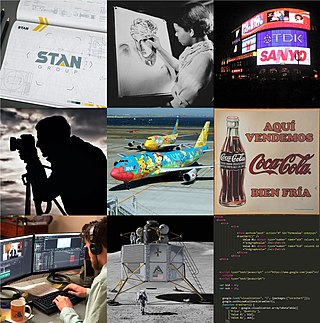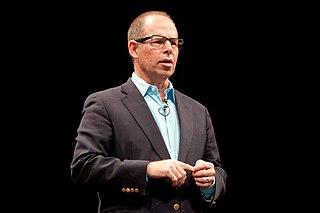Related Research Articles

Graphic design is a profession, academic discipline and applied art whose activity consists in projecting visual communications intended to transmit specific messages to social groups, with specific objectives. Graphic design is an interdisciplinary branch of design and of the fine arts. Its practice involves creativity, innovation and lateral thinking using manual or digital tools, where it is usual to use text and graphics to communicate visually.

Sam & Max is an American media franchise about Sam and Max, a pair of anthropomorphic vigilante private investigators. The characters, who occupy a universe that parodies American popular culture, were created by Steve Purcell in his youth, and later debuted in a 1987 comic book series. The characters have since been the subject of a graphic adventure video game developed by LucasArts, a television series produced for Fox in cooperation with Nelvana Limited, and a series of episodic adventure games developed by Telltale Games. In addition, a variety of machinima and a webcomic have been produced for the series.

Closed captioning (CC) and subtitling are both processes of displaying text on a television, video screen, or other visual display to provide additional or interpretive information. Both are typically used as a transcription of the audio portion of a program as it occurs, sometimes including descriptions of non-speech elements. Other uses have included providing a textual alternative language translation of a presentation's primary audio language that is usually burned-in to the video and unselectable.

Reiner Knizia is a prolific German-style board game designer. He was born in West Germany in 1957 and earned a doctorate in Mathematics from the University of Ulm before designing games full time. He is frequently included on lists of the greatest game designers of all time. Many of his hundreds of designs are considered modern classics, and many have won or been nominated for significant gaming awards, including the Spiel des Jahres and the Deutscher Spiele Preis. His notable designs include Amun-Re, Blue Moon City, Ingenious, Keltis, Lord of the Rings, Medici, Modern Art, Ra, Taj Mahal, Tigris and Euphrates, and Through the Desert. Many of his designs incorporate mathematical principles, such as his repeated use of auction mechanics.

The Designers Republic is a British graphic design studio based in Sheffield, England, founded in 1986 by Ian Anderson and Nick Phillips. They are best known for electronic music logos, album artwork, and anti-establishment aesthetics, embracing "brash consumerism and the uniform style of corporate brands". Work by tDR is held in the permanent collections of the Museum of Modern Art and the Victoria and Albert Museum.
A game programmer is a software engineer, programmer, or computer scientist who primarily develops codebases for video games or related software, such as game development tools. Game programming has many specialized disciplines, all of which fall under the umbrella term of "game programmer". A game programmer should not be confused with a game designer, who works on game design.

Yoshitaka Amano is a Japanese visual artist, character designer, illustrator, a scenic designer for theatre and film, and a costume designer. He first came into prominence in the late 1960s working on the anime adaptation of Speed Racer. Amano later became the creator of iconic and influential characters such as Gatchaman, Tekkaman, Honeybee Hutch, and Casshern. In 1982 he went independent and became a freelance artist, finding success as an illustrator for numerous authors, and worked on best-selling novel series, such as The Guin Saga and Vampire Hunter D. He is also known for his commissioned illustrations for the popular video game franchise Final Fantasy.
Graphics are visual images or designs on some surface, such as a wall, canvas, screen, paper, or stone, to inform, illustrate, or entertain. In contemporary usage, it includes a pictorial representation of data, as in design and manufacture, in typesetting and the graphic arts, and in educational and recreational software. Images that are generated by a computer are called computer graphics.

WGBH-TV, branded GBH or GBH 2 since 2020, is the primary PBS member television station in Boston, Massachusetts, United States.

In computing, a visual programming language, also known as diagrammatic programming, graphical programming or block coding, is a programming language that lets users create programs by manipulating program elements graphically rather than by specifying them textually. A VPL allows programming with visual expressions, spatial arrangements of text and graphic symbols, used either as elements of syntax or secondary notation. For example, many VPLs are based on the idea of "boxes and arrows", where boxes or other screen objects are treated as entities, connected by arrows, lines or arcs which represent relations.
Game programming, a subset of game development, is the software development of video games. Game programming requires substantial skill in software engineering and computer programming in a given language, as well as specialization in one or more of the following areas: simulation, computer graphics, artificial intelligence, physics, audio programming, and input. For multiplayer games, knowledge of network programming is required. In some genres, e.g. fighting games, advanced network programming is often demanded, as the netcode and its properties are considered by players and critics to be some of the most important metrics of the game's quality. For massively multiplayer online games (MMOGs), even further knowledge of database programming and advanced networking programming are required. Though often engaged in by professional game programmers, there is a thriving scene of independent developers who lack a relationship with a publishing company.
Raymond Larabie is a Canadian designer of TrueType and OpenType computer fonts. He owns Typodermic Fonts, which distributes both commercially licensed and shareware/freeware fonts.
Scott Kim is an American puzzle and video game designer, artist, and author of Korean descent. He started writing an occasional "Boggler" column for Discover magazine in 1990, and became an exclusive columnist in 1999, and created hundreds of other puzzles for magazines such as Scientific American and Games, as well as thousands of puzzles for computer games. He was the holder of the Harold Keables chair at Iolani School in 2008.
A creative director is a person who makes high-level creative decisions; oversees the creation of creative assets such as advertisements, products, events, or logos ; and directs & translates the creative peoples who produce the end results. Creative director positions are often found within the television production, graphic design, film, music, video game, fashion, advertising, media, or entertainment industries, but may be found in other creative organizations such as web development and software development firms as well.

Motion graphic design, also known as motion design, is a subset of graphic design which combines design with animation and/or filmmaking, video production, and filmic techniques. Examples include kinetic typography and graphics used in film and television opening sequences, and station identification logos of some television channels.

Where in the World Is Carmen Sandiego? is an American half-hour children's television game show based on the Carmen Sandiego computer game series created by Broderbund. The show was hosted by Greg Lee, who was joined by Lynne Thigpen, and the a cappella vocal group Rockapella, who served as the show's house band and comedy troupe. The series was videotaped in New York City at Chelsea Studios and Kaufman Astoria Studios and co-produced by WQED and WGBH-TV, and aired on PBS stations from September 30, 1991, to December 22, 1995, with reruns continuing to air until May 31, 1996. A total of 295 episodes over five seasons were recorded.

Wipeout is a racing video game developed and published by Psygnosis. It is the first game in the Wipeout series. It was originally released in 1995 for PlayStation and DOS, and in 1996 for Sega Saturn, being a launch title for the PlayStation in Europe. It was re-released as a downloadable game for the PlayStation 3 and PlayStation Portable via the PlayStation Network in 2007.

Michael Bierut is a graphic designer, design critic and educator, who has been a partner at design firm Pentagram since 1990. He designed the logo for Hillary Clinton's 2016 presidential campaign.

William Robert Davis, aka Bill Davis, is an American illustrator, animation director and designer, graphic designer and painter. He was the creative director at Sierra On-Line and Rocket Science Games during the 1990s. Davis is the founder and creative director of Mother Productions, a graphic design firm which creates animation, motion graphics, logos and other graphic designs for on-air and online purposes.
Graphic design is the practice of combining text with images and concepts, most often for advertisements, publications, or websites. The history of graphic design is frequently traced from the onset of moveable-type printing in the 15th century, yet earlier developments and technologies related to writing and printing can be considered as parts of the longer history of communication.
References
- ↑ "About Gene Mackles". Gene Mackles. Retrieved February 22, 2024.
- ↑ Drate, Spencer (2006). Motion by Design. London: Laurence King Publishing. p. 15. ISBN 978-1-85669-471-1 . Retrieved 2024-03-03– via Internet Archive.
- ↑ Robinson, Matt (2023-11-07). "Award-winning graphic designer now a game creator". Fifty Plus Advocate . Archived from the original on 2024-03-03. Retrieved 2024-03-03.
- ↑ "Captioning and Video Description for the Web" (PDF). WGBH. Media Access Group. Retrieved February 22, 2024.
- 1 2 3 "Oil paintings at First Parish Church in Weston". 2008-11-06. Archived from the original on 2024-03-03. Retrieved 2024-03-03.
- 1 2 3 Feely, Paul (2012-03-20). "Three finalists named for RMHS principal". Daily Times Chronicle . Archived from the original on 2024-03-03. Retrieved 2024-03-03.
- ↑ "Gene Mackles - Awards". IMDb. Retrieved February 22, 2024.
- ↑ McGagh, Ken (2009-10-07). "Photos: Painters drawn to South Natick dam". The MetroWest Daily News . Archived from the original on 2024-03-03. Retrieved 2024-03-03.
- ↑ "Gene Mackles". Board Game Geek. Retrieved February 22, 2024.
- ↑ Viccaro, Tom (2013-04-10). "Newton's Gene Mackles creates Iota, a little game that wins big". Wicked Local . Archived from the original on 2024-03-03. Retrieved 2024-03-03.
- ↑ Kylstra, Carolyn (September–October 2015). "Voices in the Wilderness. Anna Stork '08 • Melissa Cook '82 • Andrenne & Angilique Coleman '13 • Gene Mackles '68 • Alison Crocker '06 • Jason Dadakis '99". Dartmouth Alumni Magazine. Archived from the original on 2024-03-03. Retrieved 2024-03-03.
- ↑ Gough, John (January 2015). "Learning mathematics through games" (PDF). The Australian Mathematics Teacher. Vol. 71, no. 4. Australian Association of Mathematics Teachers. p. 10. ISSN 0045-0685. Archived from the original (PDF) on 2024-03-03. Retrieved 2024-03-03– via Education Resources Information Center. The article is also available here.
- ↑ Gries, Laurie E. (2015). Still Life with Rhetoric. Logan, Utah: Utah State University Press. ISBN 978-0-87421-977-7 . Retrieved 2024-03-03– via Google Books.